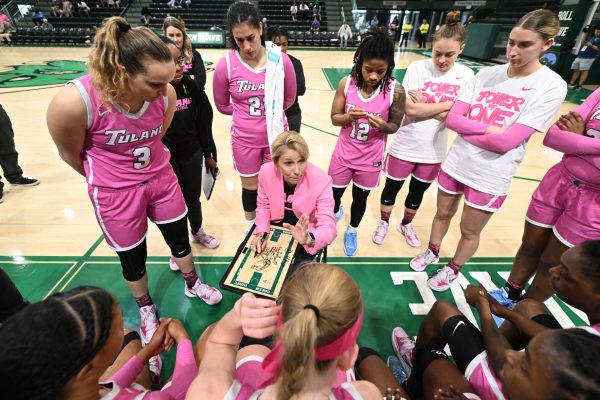No headline provided

November 11, 2011
The Shockwave dance team has been working to implement new standards for its dancers, who are now expected to adhere to a body fat percent maximum of 23.
Shockwave coach Ashley Iserman
and Shockwave captain Susan Loeb
declined to comment and team members did not respond to calls from The Hullabaloo.
Director of Bands and Shockwave Faculty Adviser Barry Spanier
said the new standards are meant to be safety precautions designed to ensure that dancers can handle the physical demands of being part of a dance team.
“Conditioning is a safety issue,” Spanier
said. “We want to make sure everyone can get through the rigors of what is needed to perform. They are artists, but they are also athletes.”
Dr. Linda Kirby from the Tulane Student Health Center said women need at least 10-12 percent body fat. Athletes, such as the dancers on Shockwave, can have 14-20 percent, but can still extend to 25 percent. In-shape for non-athletes is 21-24 percent. A person is not considered overweight until their body fat percentage goes above 31.
“I would also implement a minimum,” Kirby said. “If they are looking at the health of the dance team, they should be looking at a range.”
Spanier said that this year marks the first time these standards will be in place. In the past, Shockwave was student led, but this year, the team has a coach for the first time. She has been implementing regulations to more closely adhere with national appearance and safety norms, Spanier said.
“For a group that’s in front of the public so much, it’s important to have some professional guidance,” Spanier said.
Former Shockwave dancer Hope Luebbert said that when the team was student-led, there were no rules to regulate body fat.
“There were no [body fat percentage] standards when I was on the team,” Luebbert said. “It’s really different now.”
Spanier said that the 23 percent body fat standard is more of a target than a rule and that Shockwave is willing to work with each individual dancer to ensure that they are both healthy and fit for the team.
“Twenty-three is the ideal goal that we’re looking to achieve,” Spanier said. “That was set out as a goal, but we’re dealing with each person as an individual. We’re not expecting anyone who varies greatly from that to change suddenly and drastically. It’s a marker – here’s what we want to get to as a group, a unified look and presentation”
However, these changes to the team have caused a stir within the team. One former Shockwave dancer left the team before the new regulations were put into place, but chose to remain anonymous because of social pressure.
“I think it’s in a very wrong context at Tulane,” she said. “It’s something that big teams do, like LSU or Alabama. If we had a formidable team it would make sense because girls would come to our school and get scholarships.”
Spanier said he encourages everyone already on the team to stick with it and said that the new regulations did not specifically target anyone.
For a club to change its membership policies, it must pass its amended constitution through the Undergraduate Student Government, said USG Vice President for Student Life Michael Lewis.
“USG will investigate the situation,” Lewis said. “USG won’t allow discriminatory changes to pass in the constitution.”
There is no standard to regulate body fat percentage across college dance teams, Sheila Noone, vice president of public relations at Varsity, the parent company of the Universal Dance Association, said.
“It depends on how competitive their program is,” Noone said.
Because there is no national regulation, schools with dance teams each handle their dancers’ physical appearances differently.
“We have appearance regulations for each individual member of the dance line but no standardized requirement,” LSU Golden Girls Director Eric Melley said. “We use whatever their appearance is at the their audition time as a standard, because that’s what they look like when they make the line.”
Spanier said that though the new regulations may make people uncomfortable, they will benefit the team.
“The physicality is a reality; it’s part of the activity,” Spanier said. “I understand it can be a sensitive subject. But we’re not eliminating anybody for that reason alone. If they can dance and make the tryouts, then they can be part of the group and participate, but the level at which they participate may be limited until we feel they can visually be a cohesive member of the team.”





















Leave a Comment